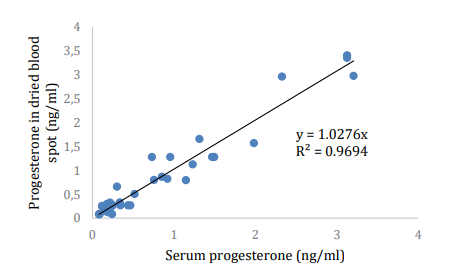Evaluation of the use of dry blood spots for progesterone determination in ewes
DOI :
https://doi.org/10.21708/avb.2022.16.4.10932Résumé
The use of dried blood spots on filter paper has been shown to be a practical alternative in several studies with humans and animals, enabling a simple means of storing and transporting viable blood samples for various laboratory analyses. However, its applicability in the measurement of progesterone in animals is scarce. Thus, the objective of this study was to evaluate the feasibility of using dried blood spots for the measurement of progesterone in sheep. In total, 38 blood samples from 6 sheep were dripped onto filter paper, and the remainder of each sample was separated into serum. The progesterone levels in the serum samples and in the dry drops were measured by enzyme immunoassay and subsequently correlated. The levels of progesterone in the serum and dry spots showed a high correlation between the matrices (R2 = 0.9694). In conclusion, this study demonstrated the feasibility of using samples of dried sheep blood spots for the measurement of progesterone, and the storage and transport technique can be applied in the field.
Téléchargements

Téléchargements
Publié-e
Numéro
Rubrique
Licence
(c) Tous droits réservés Acta Veterinaria Brasilica 2022

Cette œuvre est sous licence Creative Commons Attribution 4.0 International.
Autores que publicam na Acta Veterinaria Brasilica concordam com os seguintes termos: a) Autores mantém os direitos autorais e concedem à revista o direito de primeira publicação, com o trabalho simultaneamente licenciado sob a Licença Creative Commons Attribution que permite o compartilhamento do trabalho com reconhecimento da autoria e publicação inicial nesta revista. b) Autores têm autorização para assumir contratos adicionais separadamente, para distribuição não-exclusiva da versão do trabalho publicada nesta revista (ex.: publicar em repositório institucional ou como capítulo de livro), com reconhecimento de autoria e publicação inicial nesta revista. c) Autores têm permissão e são estimulados a publicar e distribuir seu trabalho online (ex.: em repositórios institucionais ou na sua página pessoal) a qualquer ponto antes ou durante o processo editorial, já que isso pode gerar alterações produtivas, bem como aumentar o impacto e a citação do trabalho publicado (Veja O Efeito do Acesso Livre).


 Esta obra está licenciada com uma Licença
Esta obra está licenciada com uma Licença 